#language studyblr
Explore tagged Tumblr posts
Text
JLPT N5 - あげる
At its simplest, あげる means “to give”. At the N5 level, it’s used for giving physical things such as presents, money, water (to plants), food (to pets), etc. There is another way it can be used, but that is for a later JLPT level. For now, let’s get into ONE of the ways you can talk about giving in Japanese.
First, here is the vocabulary for this post.

【The Grammar of あげる】
Basically there are 4 parts to every あげる sentence that you should be thinking about. The first 3 are marked with particles and the last part is the verb.

Here is an example sentence:
① 【けんじは】【トムに】【腕時計を】あげた。
= As for Kenji, to Tom, a watch gave
= Kenji gave Tom a watch.
In a sentence like #1 it’s easy to see the 3 parts clearly marked with particles and then the verb at the end. Unfortunately you WILL NOT always see simple sentences like this, so let’s look at each part one by one, along with the cultural context behind あげる.
【The Giver】
Most of the time, the giver will be marked by the は (or sometimes the が) particle. This is because あげる sets up the action of giving from the giver’s perspective.
Sometimes, it is obvious who the giver is, so that phrase can be completely left out of the sentence.
② 【会社の人たちに】【お土産を】あげると思う。
= to the people at (my) company, souvenirs will give I think
= I think I’m going to give the people at my company souvenirs.
In this sentence it would be clear that the speaker is the giver. Therefore it’s not necessary to include a 私は phrase.
【The Relationship Between Giver and Receiver】
Before we move on, let’s get into a very big cultural difference between Japan and English-speaking cultures. When you use あげる, you have to think about the relationship between the giver and the receiver. In English, this doesn’t affect the words we use, but in Japanese it is actually very important when it comes to word choice. Take a look at this image:

The green circle would include close friends, family, your lover, etc. Pets and plants would also fall into this circle. Outside of the green circle are strangers, teachers, professors and depending on your job, your customers. This is because showing respect is directly connected to setting up a kind of psychological distance. You have to work hard and gain trust before you are moved into the green circle.
Some people, like coworkers and bosses, may be inside the green circle in some situations, but outside of it in other situations! A common example is when you go out drinking with coworkers. As the alcohol flows throughout the night you’ll notice that psychological space slowly disappearing - that is until the next day at work. They might act like the person you drank with was a COMPLETELY different person!
This way of thinking is called うちそと, and can be a very difficult part of Japanese culture for many foreigners. Here’s the thing: the culture of うちそと extends to the concept of giving as well.
【Giving Culture and あげる】
When it comes to giving, there are 4 situations where it’s appropriate to use the verb あげる:
① When you give something to someone inside your inner circle
② When you give something to anyone outside your inner circle
③ When someone in your inner circle gives something to someone outside your inner circle
④ When someone outside your inner circle gives something to another person outside your inner circle
Numbers 1-3 can be described as the act of giving while moving from a smaller circle to a bigger circle. Number 4 can be described as giving that doesn’t happen in your inner circle.

There are of course more possibilities when it comes to giving (and receiving). However, those situations won’t use the verb あげる!
【What Is Being Given】
In most sentences, whatever is being given is very simply marked with the を particle. However, there are times when the を particle or the positioning of what is being given will change. Take a look at these three example sentences:

Example 3a is the “default version”. The doll is marked with the を particle so we immediately know that it will be given to someone (the section manager’s wife).
For example 3b I want you to imagine that you are in a souvenir shop. You’ve bought a couple of things already, but you haven‘t decided which gifts will go to whom. All of a sudden, you see a doll that catches your eye. You immediately think to yourself, “that doll is perfect for the section manager’s wife”. Putting the item being given (that is, the doll) at the head of the sentence shows that 1) you are putting the focus of your sentence on that item and 2) there is a kind of impulsiveness to the giving. It’s kind of an instant decision.
Compare that with example 3c. Now I want you to imagine that you are in your house. You bought a bunch of dolls but you haven’t decided which one will go to whom. You pick up one of them and after some thought you say, “Ok I’ll give THIS one to the section manager’s wife.” Marking the doll with は serves to emphasize that there are several dolls, but you are highlighting one of them for a specific reason. It also shows that it WAS NOT an instant decision; some thought went into your decision.
This kind of distinction takes a really long time to understand and really “feel” but I hope that by explaining it to you now, it might stay with you somewhere deep inside your mind. You might even experiment with using sentences like 3b and 3c and surprise your Japanese friends!
【Alternative Verbs】
Lastly, let’s talk about your choice of verbs. You can actually adjust the level of “closeness” that the reader / listener feels by changing the verb that you use! あげる, あげた, あげます, あげました, etc. is used for a “default” level of closeness.
However, if the receiver is someone in a higher social position (for example a professor, a doctor, a boss, a politician, etc.) you would instead use the similar verb さしあげる. This verb actually serves to humble yourself - and thus elevates the listener / reader.
④ 【この本は】ただでさしあげます。
= as for this book, for nothing will give
= I will give you this book for free.
From this sentence you can tell that the giver and the receiver are on different levels, socially. (This is a little different than うちそと.) The listener will feel an elevated level respect simply by hearing the さしあげる verb.
On the other hand, if the receiver is someone VERY close to you, you can show that closeness by using the verb やる instead of あげる. やる is often used with pets and plants.
⑤ 【彼女は】【犬に】【えさを】やるのを忘れた。
= as for her, to (her) dog food giving forgot
= She forgot to give her dog food.
As it turns out, this is why I keep on saying “what is given” instead of “a present” or “a gift”. Giving water to plants or food to pets is not a present or a gift.
Here is a visual representation of the 3 different verbs that you can use when talking about giving (from the giver’s perspective):

Here is 1 last example:

= as for apples I give to you, there are none
= I don’t have any apples to give you.
As you can see in #6, it’s possible to state a giver, a receiver and then あげる in order to describe what is being given. Once you do that, you will then have a topic which you can then go on to make a comment about!
【Conclusion】
So there you have it! あげる and its related verbs (さしあげる and やる) all express the idea of giving from the giver’s perspective. However, you have to keep the Japanese concept of うちそと in mind. Later we’ll talk about giving but from the receiver’s perspective. Stay tuned!
Rice & Peace!
-AL (アル)
👋🏾
#日本語#japanese studyblr#japanese grammar#japanese language#isshonihongo#japanese culture#あげる#jlptn5#jlpt#japanese#learn japanese#japanese lesson#japanese study#studying japanese#japaneselessons#learnjapanese#japanese langblr#japanese vocab#japanese vocabulary#language#languages#language study#language studyblr#language blr#日本語の勉強#にほんご
151 notes
·
View notes
Text


(11/30) Recently I explained the concept of dépaysé(e), which literally translates to “de-countried”. Before I learned this word I could never eloquently describe why it always felt so off to be back in Ireland, and how I tend to feel a bit lost and foreign there despite being Irish. It can also be used in a positive context though! You could describe a holiday being great bcs everything felt so different, j’ai été dépaysé(e) ☕️
#I still love Ireland & it’s still my home ! But after living my entire adult life in France it feels so different than before I moved 😅#studyblr#French#french langblr#language learning#language studyblr#dark academia#light academia#30dop#30nym#Langblr#foreign languages#language study
819 notes
·
View notes
Text



Language Resources 🎀
*that I currently use for studying Spanish. When I pick up studying Japanese again, I will make a list for that as well <3 I currently use a handful of resources for learning Spanish, and they've all proven very useful so far!
🩷 My Current Resources for Spanish
Busuu - hands down my favorite language learning app. So much better than Duolingo, in my opinion (especially for languages with a different alphabet/writing system). I bought the premium for a year, which will expire in Septmeber, but I'm debating renewing again because I love it so much.
LingQ - I like using this for reading in Spanish. It gives me different types of things to read about, and while I don't have premium, I do put all the words I don't know into flashcards on AnkiApp on my laptop and translate anything I don't know using SpanishDict.
SpanishDict - favorite translation/dictionary app. I know it has lessons you can use, tho I haven't tried it yet, but I really do love this app. It's super helpful when I'm making flashcards or writing random vocabulary notes.
Goodnotes - This is a general note-taking app, but I love it because it allows you to import and write on PDFs, and that's just perfect for me! I've downloaded free PDF short stories/children's stories in Spanish and made notes of words I don't know, and taken notes in the app too. Definitely my favorite notes app, ever.
Italki - I know this is a website, too, but I use the app. It lets you work with professional teachers/community tutors in your target language. You can have structured lessons or just use it for conversation practice. I did a trial lesson not too long ago and have an upcoming lesson booked out in about 5 days. You pay per lesson, so there is no subscription, and there are so many languages and teachers/tutors to choose from. I did a lot of research before choosing a teacher, and I'm very happy with my decision so far. Definitely useful if there's not native speakers near you or you're like me and not confident talking to people you know in your target language/their native language.
Quizlet/AnkiApp - I use AnkiApp more then quizlet, and the Anki I'm referring to is NOT the same way everyone else uses, but it's the flashcard app of preference at the moment. I tried the AnkiDroid app and hated it. But yeah, AnkiApp is useful for flashcards and I really like it. I have it on my Chromebook and my Ipad.
Netflix - I love watching shows in Spanish on Netflix so much. I am currently watching La Reina del Sur on it (used to watch that sporadically in the past at a friend's house) and plan on watching some other shows, including Elite.
Spotify - I enjoy listening to Spanish music and podcasts right now. The music is more of an entertaining/enjoyable fork of audio input, and the podcasts help me get a feel for speaking and pronunciation and I choose podcasts that speak on topics of interest tk help with vocabulary in those areas I'd like to be able to speak about.
Textbooks - I have 2 PDF textbooks, Gramatica de Uso del Español: A1-B2 and Gramatica de Uso del Español: B1-B2. I've heard these are great for learning Spanish (and they're both only written in Spanish, like there's no English in them) and plan on using them once I figure out how to take good and useful textbook notes! I definitely need to improve on my grammar.
Those are all my current Spanish resources! I'd definitely say my current level is like a high A1 right now, nearing A2, but I have just a little bit of work to do before I get there. These resources are definitely gonna help, tho!
#studyblr#study motivation#it girl#langblr#spanish langblr#study tips#language goals#that girl#langblog#language resources#foreign languages#language learning#language#langblr community#learn spanish#language learning goals#language studyblr#college studyblr#study blog#studying#language study tips#college student#student life#university student#language student#spanish#language learning tips#spanish studyblr#spanish language#study community
276 notes
·
View notes
Text



Re-Introduction 🎀
Hello!!! With the start of the school year coming soon for me, I decided I'd reintroduce myself, as this is my main blog and I typically use it as a studyblr-type of blog because it helps keep me going towards my goals! Of course i still post about my physical health, mental health, and daily life, but when college/university is in session, my life typically revolves around school!
🎀 A Little About Me 🎀
you guys can call me Rosey 🌹
I am 21 years old, she/her
I am entering my 4th year of college/uni BUT I recently added a 2nd major so I don't graduate for another year/year and a half ish
I am majoring in Human Nutrition and Dietetics, 2nd major in Finance, and a double minor in Psychology and Exercise Science
I love learning so so so much, as you can tell
I study languages in my free time
^ Currently rotating between (Mexican) Spanish, Japanese, and Korean
I love all things health, fitness, and wellness
I love to work out! My favorite ways to work out right now are weight lifting, walking, mat pilates, and yoga! My university offers workout classes for free to full time students so I'll be taking yoga/pilates classes at my campus!
I do work a full-time, on-campus food service job. 40 hours of work a week, and 15 college credit hours this semester 😅
I love to read, write, listen to music, and want to pick up more hobbies such as sewing, dance, crochet, drawing, painting, etc
This account started out as a "wonyoungism" account and slowly turned into my own little safe space where I am free to be myself without fear of judgment. Of course my aesethic is still pink and wonyoungism ish but I do fully plan on turning this into a more studyblr type of account using my own photos once university starts back up! So stay tuned for that little transition!
I'm always open to questions and I love giving advice and helping others! Whether it's something academic related, personal goal related, whatever, I'm always here to help if I can! <3 I love this little community i have <3
I've said so much already, lol, my bad. I'm just so excited for this upcoming semester. I don't know what it is about it, but I have such a feeling this will be a good school year for me! Feel free to drop an ask, or a comment, or anything! I will be making more posts of more academic related topics soon!
til next time lovelies 🩷
#pink pilates girl#pink pilates princess#self development#it girl#wonyoungism#mental health#self care#that girl#physical health#self love#studyblr#langblr#lifeblr#uniblr#university student#college student#that girl energy#becoming that girl#it girl self care#it girl energy#clean girl aesthetic#clean girl#pink academia#pink blog#pilates aesthetic#student life#college life#language studyblr#college studyblr#university life
181 notes
·
View notes
Text
🌿Study with me! 07.08.24🌿
📖 Subject: French Grammar: Impersonal Verb Constructions
⏳️ Time: 25 minutes
📍Location: The British Library, King's Cross, London
First French exam tomorrow and I just KNOW they're gonna try and catch us out with an impersonal construction in the translation portion. NOT TODAY KCL, NOT TODAY
#study with me#studyblr#studyspo#student#academia#dark academia#light academia#french#languages#language studyblr#mine#videos#timelapse#study motivation
99 notes
·
View notes
Text
How do you guys keep studying when you feel like you've hit a wall? I got distracted for a couple days from my Japanese studies both because of world events and because of video games and now I'm struggling to get that spark back ;-;
Any help and advice is appreciated!
I'm also looking for a sort of study buddy/accountability friend who can help me (and get help from me in return) keep to my studies instead of letting myself slip like this again!
Requirements
18-30 age range (I'm an adult and I would prefer to study with someone who is as well)
Learning a new language
Willing to talk over either tumblr IM or discord messages
Calls are likely not to happen as I share a room/workspace with someone else in my house.
71 notes
·
View notes
Text
I hid all my textbooks. I can't stop crying and sobbing. I can't deal with it right now. Another year feeling like a failure. I'm too old to be so useless.
#studyblr#study blog#studying#millennial studyblr#language studyblr#language study#language degree#language certificate
0 notes
Text
*This poll was submitted to us and we simply posted it so people could vote and discuss their opinions on the matter. If you’d like for us to ask the internet a question for you, feel free to drop the poll of your choice in our inbox and we’ll post them anonymously (for more info, please check our pinned post).
#language#languages#learnlanguages#learning#poll#polls#studying#studyblr#study#tumblr polls#tumblr poll#incognito polls#poll time#random polls#fun polls
7K notes
·
View notes
Text
THE DAY OF LANGUAGES!!!
This 7th of May, 2025, we use our own language again!
If your language, native or not, is something other than English, on May 7th you can speak that language all day!
You’ll blog in your chosen language(s) all day: text posts, replies, tags (except triggers and organisational tags).
Regardless of what language people choose to speak to you, you can answer in your own.
Non-verbal, non-written languages (like sign language and dialects) are more than welcome! See my FAQ for tips
English native speakers can participate in any other language they're studying/have studied/know.
The tag is gonna be #Speak Your Language Day or #spyld for short.
Please submit me some language facts for me to share on this day <3
Pinned post and FAQ
3K notes
·
View notes
Text


coffee + ancient greek ˖˚⊹ ꣑ৎ (or pics from study sessions that i never posted)
#studyblr#study blog#studying#studyinspo#studyspo#ancient greek#study motivation#uni studyblr#dark academia#study aesthetic#study inspiration#study inspo#study movitation#uniblr#langblr#ancient greek language#language blr#language learning#language study#student life#uni life#uni student#university student
2K notes
·
View notes
Text
alright nerds--
^tried to include as many as possible
#studyblr#polls#tumblr polls#academics#academic polls#studyblr polls#studying#learning#college#university#academic#language#langblr#archaeology#anthropology#sociology#psychologoy#psych#medblr#history#forensics#csi#math#physics#mathblr#mathematics#computer science#science#compsci#biology
1K notes
·
View notes
Text
The Basic 46
This may be your very first page on your road to learning Hiragana! Either way, welcome!
There are 46 basic Hiragana characters. 6 of them are represented by a single English letter, while 3 of them are represented by three letters. The remaining 37 are all represented by two characters.
【Romaji】
First let’s talk about Romaji. You may have heard that Japanese has 3 sets of characters to express the language – Hiragana, Katakana, and Kanji. While that is true, there is a fourth set of characters and that is Romaji!
If you see the word “sake” you automatically read it as a word that rhymes with “take” and means “for the benefit of someone or something”. However, this is the English reading of the word. If you look at that word as Romaji, it is pronounced as “sah-keh” and it means Japanese alcohol.
Romaji is not English. It is an attempt at writing Japanese words with the English alphabet. There are sounds in each language that are not in the other, so relying on Romaji for too long is not a good idea. It is really only useful when you are beginning to learn Hiragana (and maybe 1 or 2 instances after that).
【Order】
Just like how we have something called “alphabetical order”, there is also an order to Hiragana (and katakana as well). To remember the order, there are several mnemonics that people use but the one I’ve always used is:
Kana Signs, Think Now How Many You Really Want
Keep in mind that these are only for the consonant sounds. And with that, now let’s look at those 46 characters!
【The Vowel Group (あいうえお)】
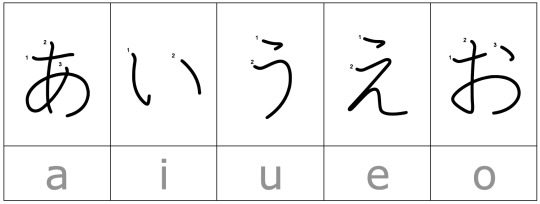
These 5 characters are the vowels of Japanese. While English (depending on where you are from) can have anywhere from 24 to 27 different vowel sounds, the GOOD NEWS is that Japanese only has these 5!
【The K Sound Group (かきくけこ)】
At this point we need to be aware of a big difference between Japanese and English. If I asked you to break down the sounds of the word “kid”, you would tell me the 3 individual sounds for each letter. But in Japanese, the ”k” and “i” sounds MUST go together. The majority of Japanese hiragana characters are made up of a consonant-vowel pair.
This is why almost all of our remaining hiragana characters need either two or three English letters. The K Sound Group 2 is simply the consonant “k” sound and each of the 5 vowel sounds.

【The S Sound Group (さしすせそ)】
Our next group is made up of the consonant “s” sound and each of the 5 vowel sounds. However, in this group we have our first irregular character!
According to the pattern so far, you would think that the し character would be pronounced “si”, as in the Spanish word for “yes”. In actuality, it’s pronounced “shi” like the English word “she”. This is something to take a mental note of.

【The T Sound Group (たちつてと)】
The next group is mostly made up of consonant “t” sound and each of the 5 vowel sounds. This time, we have two irregular characters! Instead of sounding like the English word “tea”, the character ち sounds like the second syllable of the English word “catchy”.
Unfortunately, the character つ doesn’t have any equivalent sound in English. Instead of sounding like the Spanish word for you (tu), the closest we can get is trying to make the “t” sound while saying the name “Sue”! This character took me a bit of practice and a lot of time to master.

【The N Sound Group (なにぬねの)】
Good news: The next group doesn’t have any irregular characters, so it is pretty straightforward!
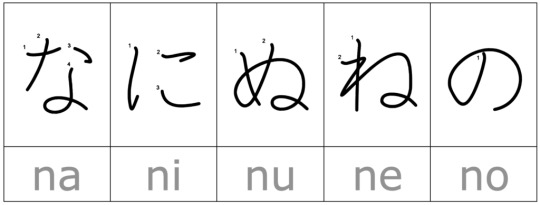
【The H Sound Group (はひふへほ)】
The H Sound Group has one irregular character. You might be tempted to think that ふ is pronounced as “hu”. If you look at the English representation, you might think that it’s pronounced as the first part of the word “fool”. In actuality it is pronounced somewhere in between! Just like つ, this character took me some time to get right.

【The M Sound Group (まみむめも)】
This group is also pretty straightforward. No irregular pronunciations here!
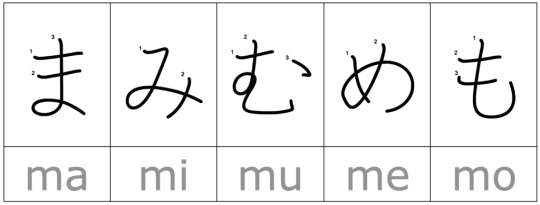
【The Y Sound Group (やゆよ)】
You’ll notice that this group only has three characters. There used to be characters for the sounds “yi” and “ye” but they dropped out of modern use.
Also, these 3 characters are very important for making another set of sounds. We’ll get into that in a later post.

【The R Sound Group (らりるれろ)】
This group appears to be simply the 5 vowel sounds added to the consonant “r” sound, however it isn’t that simple.
As you may or may not know, Japanese people have a very hard time pronouncing and differentiating between the English “r” and “l” sound. The reason is that they don’t have those sounds in Japanese. Unfortunately that also means that these 5 characters are not easy for native English speakers to pronounce. Each character’s pronunciation is actually somewhere between an “r” and an “l” sound. These characters took me the longest time to master (especially in long words!)
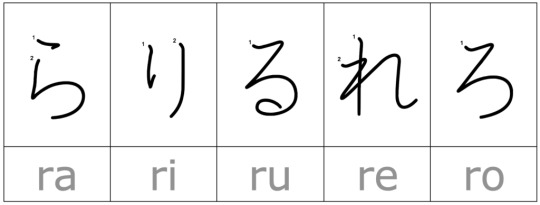
【The W Sound Group (わを)】
This group only has 2 characters. The thing of note here is that を sounds almost identical to the character お. を is only used as a particle, so it will never appear in the middle of a word. Also, when it’s used as a particle, you might be able to hear a slight pause after it. These kinds of tricks make it easy to figure out when you are hearing を and when you are hearing お.

【ん】
The last basic character is ん. This is actually the only character that can be represented by a single consonant. It is mostly easy to tell when you are hearing this character, but there will be times when its pronunciation changes. More on that later.

【Conclusion】
So there you have it! Some people say that you can learn all 46 characters in 2 days, others say it should only take a week. It took me longer than that and so I say, take your time! There is no race to learn them so go at your own pace. Make sure that you have a good time while you practice; you’ll be more likely to remember the characters that way. Hiragana are important for learning Kanji down the line so it’s best to do it right the first time. Good luck!

#learn hiragana#hiragana#japanese#日本語#japanese studyblr#japanese language#learn japanese#日本語の勉強#language studyblr#にほんご#isshonihongo#language blr#languages#studying japanese#japanese study#studyblr
34 notes
·
View notes
Text
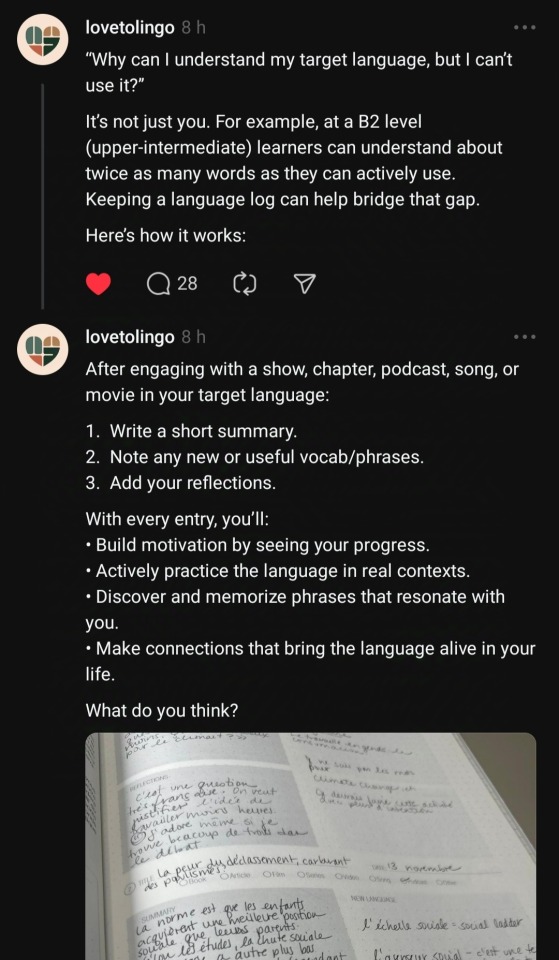
I very much agree with these suggestions. Forcing myself to write was the way I could finally start to become an active rather than a passive user of the target language.
3K notes
·
View notes
Text



Current Study Split 🎀
I am currently studying Spanish and Korean, and while I want to spend more time on Spanish because I'm at the point of beginning to speak Spanish and am still an absolute beginner in Korean, my brain keeps trying to make me focus more on Korean because I'm having so much fun with it. So here is the way my week is broken up, with a little bit of insight into how I like to study for the languages.
Sunday - Spanish
Monday - Spanish
Tuesday - Spanish
Wednesday - Korean
Thursday - Korean
Friday - Korean
Saturday - Whichever I Want
My main ways of studying Spanish are:
Busuu
Listening to music
Actively listening to and studying podcasts
Actively watching and studying from movies/TV shows
Practicing flashcards + vocabulary
Italki lessons whenever I get the money
My main ways of studying Korean are:
Busuu
Learn Korean with Billy Go on YouTube
Passively listening to music
Passively watching kdramas
Practicing vocabulary
Practicing Hangul via writing + flashcards
Italki lessons when I have the money
*I want to start using Talk to Me in Korean, but I don't have the money for a subscription just yet. My italki teacher advised me to focus on Hangul and light vocab for now, given my (lack of) current skill in the language.
*My Spanish italki teacher gave me some good advice for studying using podcasts that I can't wait to try out. She said it'll be useful for our next lesson so I can come prepared with something to speak about. Not to sure how I feel about continuing lessons with her but I'll give it a couple more tries and see how it goes. I do like her, but I don't know if it'll be the out helpful with the way she runs our lessons.
I will start posting monthly goals for my languages starting in August! I think it'll help me guide my studies a bit and help me check my progress.
til next time lovelies 🩷
#college student#college studyblr#foreign languages#it girl#langblr#language goals#language learning#language resources#language studyblr#spanish#korean langblr#languages#langblog#langblr community#spanish langblr#spanish language#korean language#study blog#study motivation#language learning goals#languageblr#language study#studying#studyspo#korean studyspo#spanish studyspo#spanish studyblr#korean studyblr#language#learning
48 notes
·
View notes
Text
Spanish Media/Input Recommendations?
Can you guys comment me some good media/input recommendations for someone learning Mexican/Spain Spanish? I' talking about any and all that you guys find interesting, whether you learned Spanish on your own or it's your native language!
Books
Podcasts
Tv Shows
Movies
Youtube channels
Songs/Musical Artists
Favorite Spanish teachers/tutors on Italki
Literally anything!
Thank you guys <3
#spanish studyblr#spanish langblr#spanish learning#spanish language#spanish#langblr#langblog#language tips#language learning#foreign languages#languages#language studyblr#language study#language goals#learn spanish#italki#spanish podcast#spanish books#university student#college student#español#mexican spanish#student life#student#college studyblr#college studyspo#language resources#language blog#languageblr#language learning tips
242 notes
·
View notes
Text
One More List of "Beautiful" Words
to include in your next poem/story
Beneficence - the quality or state or doing or producing good.
Calefaction - the state of being warmed.
Callosity - lack of feeling or capacity for emotion.
Cicatrizant - promoting the healing of a wound or the formation of a cicatrix.
Estivo-autumnal - relating to or occurring in the summer and autumn.
Evagation - a wandering of the mind.
Hamartia - a defect of character : error, guilt, or sin especially of the tragic hero in a literary work.
Imparadise - to make supremely happy, transport with delight or joy.
Impedimenta - things that impede or hinder progress or movement.
Inhesion - the condition of being inherent in something.
Jocoserious - mingling mirth and seriousness.
Lowery - gloomy, lowering.
Malobservation - erroneous observation or interpretation
Mordacious - biting or sharp in manner or style.
Natation - the action or art of swimming.
Pandiculation - a stretching and stiffening especially of the trunk and extremities (as when fatigued and drowsy or after waking from sleep).
Pestiferous - dangerous to society; pernicious.
Satisdiction - the condition of having said enough.
Ugsome - frightful, loathsome.
Unclubbable - having or showing a disinclination for social activity: unsociable.
If any of these words make their way into your next poem/story, please tag me, or leave a link in the replies. I would love to read them!
More: Lists of Beautiful Words ⚜ Word Lists ⚜ Writing Resources PDFs
#writing prompt#writeblr#poetry#writers on tumblr#poets on tumblr#literature#words#spilled ink#creative writing#langblr#studyblr#dark academia#light academia#lit#language#linguistics#writing reference#word list#beautiful words
3K notes
·
View notes